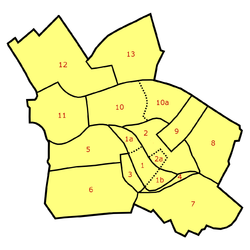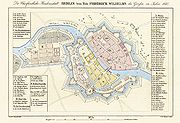
Dorotheenstadt
Encyclopedia


Berlin
Berlin is the capital city of Germany and is one of the 16 states of Germany. With a population of 3.45 million people, Berlin is Germany's largest city. It is the second most populous city proper and the seventh most populous urban area in the European Union...
, Germany
Germany
Germany , officially the Federal Republic of Germany , is a federal parliamentary republic in Europe. The country consists of 16 states while the capital and largest city is Berlin. Germany covers an area of 357,021 km2 and has a largely temperate seasonal climate...
, which forms part of the locality (Ortsteil) of Mitte
Mitte (locality)
Mitte is a central locality of Berlin in the homonymous district of Mitte. Until 2001 it was itself an autonomous district....
within the borough {Bezirk) also called Mitte
Mitte
Mitte is the first and most central borough of Berlin. It was created in Berlin's 2001 administrative reform by the merger of the former districts of Mitte proper, Tiergarten and Wedding; the resulting borough retained the name Mitte. It is one of the two boroughs which comprises former West and...
. It contains several famous Berlin landmarks: the Brandenburg Gate
Brandenburg Gate
The Brandenburg Gate is a former city gate and one of the most well-known landmarks of Berlin and Germany. It is located west of the city centre at the junction of Unter den Linden and Ebertstraße, immediately west of the Pariser Platz. It is the only remaining gate of a series through which...
, the Pariser Platz
Pariser Platz
Pariser Platz is a square in the centre of Berlin, Germany, situated by the Brandenburg Gate at the end of the Unter den Linden. The square is named after the French capital Paris in honour of the Allied occupation of Paris in 1814, and is one of the main focal points of the city.-History :Pariser...
, and Unter den Linden
Unter den Linden
Unter den Linden is a boulevard in the Mitte district of Berlin, the capital of Germany. It is named for its linden trees that line the grassed pedestrian mall between two carriageways....
.
Location
Dorotheenstadt is bordered in the west by the Großer TiergartenGroßer Tiergarten
The Großer Tiergarten, simply known as Tiergarten, is an urban public park of Germany located in the middle of Berlin, completely in the homonymous locality...
, in the north by the River Spree
Spree
The Spree is a river that flows through the Saxony, Brandenburg and Berlin states of Germany, and in the Ústí nad Labem region of the Czech Republic...
, in the northeast by the Kupfergraben (part of the Spree canal system), in the east by Hinter dem Gießhaus and Oberwallstraße and in the south by the Behrenstraße.
History
In 1670, the "Great ElectorPrince-elector
The Prince-electors of the Holy Roman Empire were the members of the electoral college of the Holy Roman Empire, having the function of electing the Roman king or, from the middle of the 16th century onwards, directly the Holy Roman Emperor.The heir-apparent to a prince-elector was known as an...
" Frederick William made a gift to his second wife, Sophie Dorothea
Sophia Dorothea of Holstein
Dorothea Sophia of Schleswig-Holstein-Sonderburg-Glücksburg was a German noblewoman. The highest title she acquired through marriage was Electress of Brandenburg as the wife of Frederick William, Elector of Brandenburg, the "Great Elector".- Biography :Sophia Dorothea was born in Glücksburg...
of Schleswig-Holstein-Sonderburg-Glücksburg, of the Cölln
Cölln
In the 13th century Cölln was the sister town of Old Berlin , located on the southern Spree Island in the Margraviate of Brandenburg. Today the island is located in the historic core of the central Mitte locality of modern Berlin...
estate of Tiergarten, located between the wall surrounding Berlin and the Großer Tiergarten. A new settlement, initially called Neustadt (New Town), was laid out according to a strict rectangular street grid planned by Joachim Ernst Blesendorf, the Overseer of Fortifications and Construction, between the Georgenstraße in the north and the Schadowstraße in the south. Neustadt received town privileges
Town privileges
Town privileges or city rights were important features of European towns during most of the second millennium.Judicially, a town was distinguished from the surrounding land by means of a charter from the ruling monarch that defined its privileges and laws. Common privileges were related to trading...
in 1674 and was renamed Dorotheenstadt in Sophie Dorothea's honour in 1681, although the term was in use earlier.
In 1709, Dorotheenstadt was united with the two cities of Berlin and Cölln and the other two electoral 'new towns' of Friedrichswerder and Friedrichstadt
Friedrichstadt (Berlin)
Friedrichstadt was an independent suburb of Berlin, and is now a historical neighborhood of the city itself. The neighborhood is named after the Prussian king Frederick I.-Geography:...
to form the "royal capital and residence city" of Berlin. As the 18th century continued, it was extended to the Spree in the north and the Tiergarten in the west. Originally the new towns were overwhelmingly residential, filled with stone houses 2 or 3 storeys in height, but in the second half of the 19th century, large government and business buildings replaced them. The eastern part of Dorotheenstadt, near the museums, developed into an academic area, including the Berlin University (now Humboldt University) and the Berlin State Library
Berlin State Library
The Berlin State Library is a library in Berlin, Germany and a property of the Prussian Cultural Heritage Foundation.-Buildings:The State Library runs several premises, three of which are open for users, namely House 1 in Unter den Linden 8, House 2 in Potsdamer Straße 33 and the newspaper archive...
. Following the construction of the Berlin Stadtbahn in 1880, a vibrant urban centre grew up around Friedrichstraße station alongside the desirable and elegant district of Unter den Linden. The population fell from 20,144 in 1867 to 11,492 in 1910, as the area became less residential. In 1920, with the creation of Greater Berlin, Dorotheenstadt was incorporated into the newly created borough of Mitte.
After extensive destruction in World War II and the incorporation of Mitte into the Soviet Zone which became East Berlin
East Berlin
East Berlin was the name given to the eastern part of Berlin between 1949 and 1990. It consisted of the Soviet sector of Berlin that was established in 1945. The American, British and French sectors became West Berlin, a part strongly associated with West Germany but a free city...
, many historic buildings, among them the Humboldt University, the Berlin State Opera
Berlin State Opera
The Staatsoper Unter den Linden is a German opera company. Its permanent home is the opera house on the Unter den Linden boulevard in the Mitte district of Berlin, which also hosts the Staatskapelle Berlin orchestra.-Early years:...
and the Alte Bibliothek were rebuilt under the German Democratic Republic
German Democratic Republic
The German Democratic Republic , informally called East Germany by West Germany and other countries, was a socialist state established in 1949 in the Soviet zone of occupied Germany, including East Berlin of the Allied-occupied capital city...
. Since German reunification
German reunification
German reunification was the process in 1990 in which the German Democratic Republic joined the Federal Republic of Germany , and when Berlin reunited into a single city, as provided by its then Grundgesetz constitution Article 23. The start of this process is commonly referred by Germans as die...
in 1990, the western part of Dorotheenstadt around the Pariser Platz
Pariser Platz
Pariser Platz is a square in the centre of Berlin, Germany, situated by the Brandenburg Gate at the end of the Unter den Linden. The square is named after the French capital Paris in honour of the Allied occupation of Paris in 1814, and is one of the main focal points of the city.-History :Pariser...
has also been rebuilt.
Major buildings and landmarks
- Pariser PlatzPariser PlatzPariser Platz is a square in the centre of Berlin, Germany, situated by the Brandenburg Gate at the end of the Unter den Linden. The square is named after the French capital Paris in honour of the Allied occupation of Paris in 1814, and is one of the main focal points of the city.-History :Pariser...
- Brandenburg GateBrandenburg GateThe Brandenburg Gate is a former city gate and one of the most well-known landmarks of Berlin and Germany. It is located west of the city centre at the junction of Unter den Linden and Ebertstraße, immediately west of the Pariser Platz. It is the only remaining gate of a series through which...
- U.S. EmbassyEmbassy of the United States in BerlinThe Embassy of the United States in Berlin maintains diplomatic relations and represents United States interests in dealing with the German government. The U.S. Embassy in Germany has not always been in Berlin.-1797–1930:...
- Academy of ArtsAkademie der KünsteThe Akademie der Künste, Berlin is an arts institution in Berlin, Germany. It was founded in 1696 by Elector Frederick III of Brandenburg as the Prussian Academy of Arts, an academic institution where members could meet and discuss and share ideas...
- French Embassy
- Brandenburg Gate
- WilhelmstraßeWilhelmstraßeThe Wilhelmstrasse is a street in the center of Berlin, the capital of Germany. Between the mid 19th century and 1945, it was the administrative centre, first of the Kingdom of Prussia and then of the unified German state, housing in particular the Reich Chancellery and the Foreign Office...
- Marschall Bridge
- Jakob-Kaiser-Haus
- British Embassy
- Unter den LindenUnter den LindenUnter den Linden is a boulevard in the Mitte district of Berlin, the capital of Germany. It is named for its linden trees that line the grassed pedestrian mall between two carriageways....
- Russian Embassy
- Komische OperKomische Oper BerlinThe Komische Oper Berlin is an opera company in Berlin, Germany, which specializes in German language productions of opera, operetta and musicals....
- Humboldt University
- StaatsbibliothekBerlin State LibraryThe Berlin State Library is a library in Berlin, Germany and a property of the Prussian Cultural Heritage Foundation.-Buildings:The State Library runs several premises, three of which are open for users, namely House 1 in Unter den Linden 8, House 2 in Potsdamer Straße 33 and the newspaper archive...
- Alte Bibliothek
- BebelplatzBebelplatzThe Bebelplatz is a public square in the central Mitte district of Berlin, the capital of Germany.The square is located on the south side of the Unter den Linden boulevard, a major east-west thoroughfare in the city centre...
- Berlin State OperaBerlin State OperaThe Staatsoper Unter den Linden is a German opera company. Its permanent home is the opera house on the Unter den Linden boulevard in the Mitte district of Berlin, which also hosts the Staatskapelle Berlin orchestra.-Early years:...
- Statue of Frederick the Great
- Neue WacheNeue WacheThe Neue Wache is a building in central Berlin, the capital of Germany. It is located on the north side of the Unter den Linden, a major east-west thoroughfare in the centre of the city. Dating from 1816, the Neue Wache was designed by the architect Karl Friedrich Schinkel and is a leading example...
- FriedrichstraßeFriedrichstraßeThe Friedrichstraße is a major culture and shopping street in central Berlin, forming the core of the Friedrichstadt neighborhood. It runs from the northern part of the old Mitte district to the Hallesches Tor in the district of Kreuzberg...
- Weidendammer BridgeWeidendammer BridgeThe Weidendammer Bridge is an long bridge where the Friedrichstrasse crosses the Spree river in the central Mitte district of Berlin, Germany...
- AdmiralspalastAdmiralspalastThe Admiralspalast is a theatre in the Mitte district of Berlin, Germany, located on Friedrichstraße No. 101. Opened in 1910, it is one of the few preserved variety venues of the pre-World War II era in the city....
- Friedrichstraße station
- Weidendammer Bridge
Cultural mentions
- Jens Gerlach, an East German poet, wrote a collection of poems called Dorotheenstädtische Monologe (Berlin: Aufbau, 1972)
Sources
- Hermann Zech. Die Dorotheenstadt in Berlin-Mitte. Berlin: H. Zech, 2000. ISBN 3980491420

